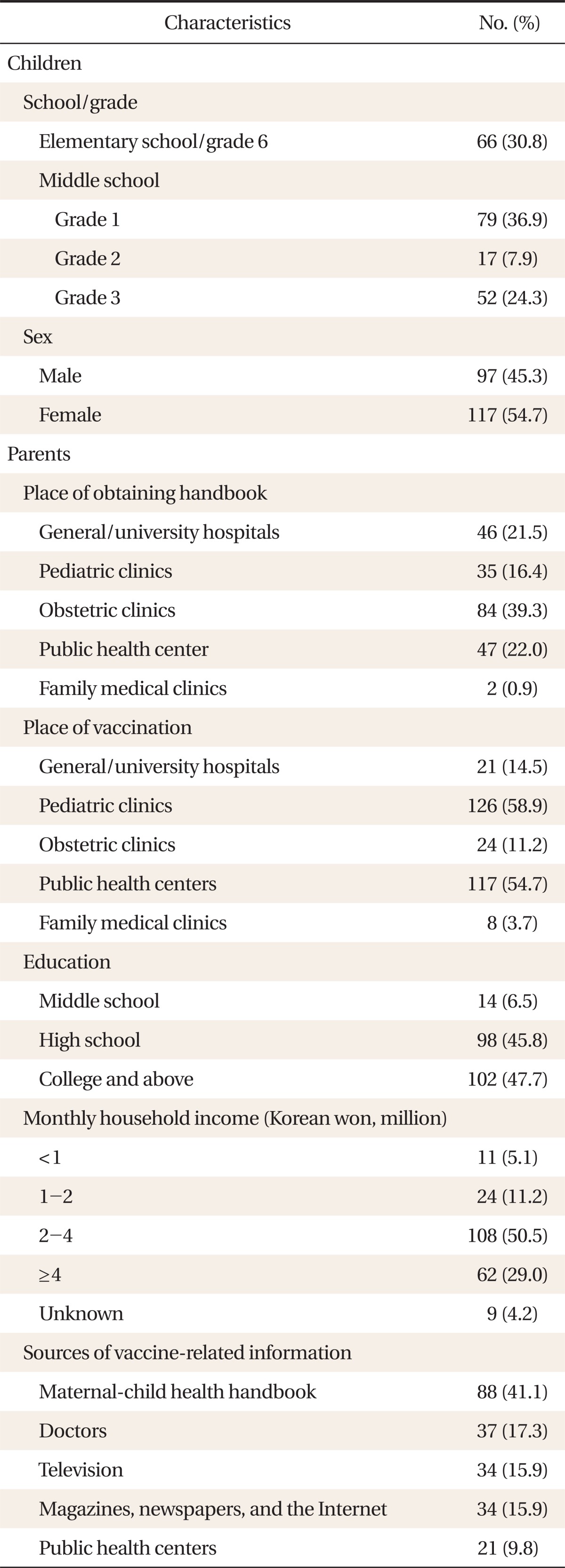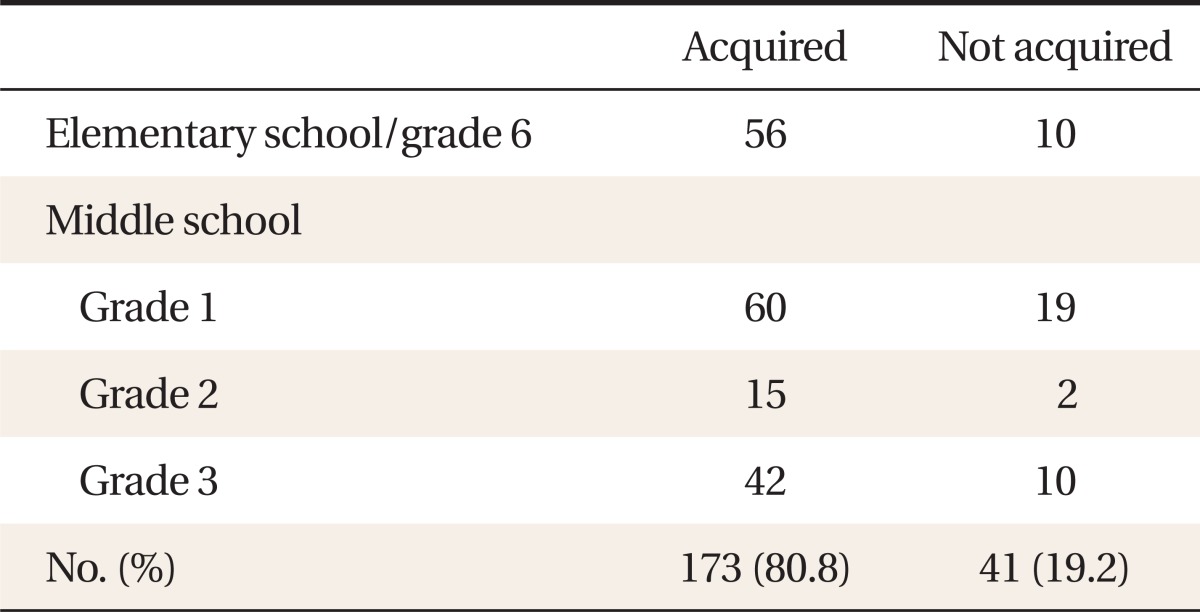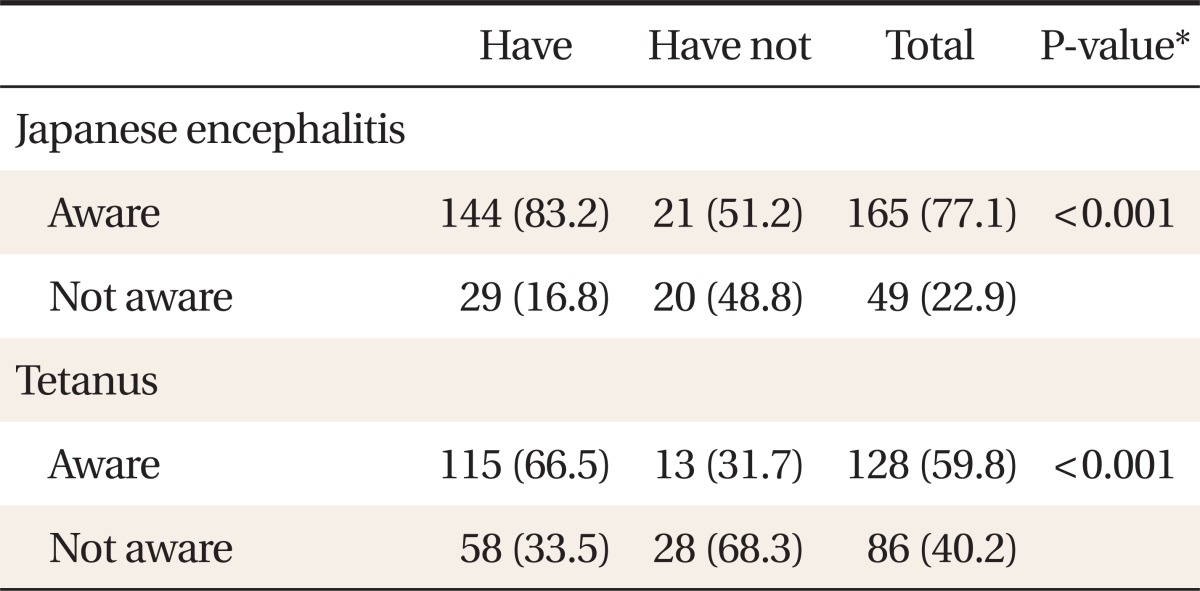Retention of the Mother and Child Health Handbook and Additional Immunization of Japanese Encephalitis and Tetanus Vaccine
Article information
Abstract
Background
Improvement of additional immunization rate is indicated as an important factor for effective immunization of diseases. In this study, the relationship between retention of mother and child health handbook and additional immunization rate of Japanese encephalitis and tetanus was examined.
Methods
A survey via questionnaire was performed against parents of students of middle schools in Gwangmyeong-si, Gyeonggi-do, and elementary schools in Seoul. Among 350 copies of the questionnaire delivered via post mail, 261 copies were collected and used in the analysis. The questionnaire included general features of subjects and their children, retention of the mother and child health handbook, and recognition of additional immunization of the Japanese encephalitis and tetanus vaccine.
Results
It was found that 80.8% of subjects answered affirmative to retaining the mother and child health handbook, and the group retaining the handbook had higher recognition rate of the need for additional immunization than the group that did not, for the Japanese encephalitis vaccine (83.2% vs. 51.2%, P < 0.001) and for the tetanus vaccine (66.5% vs. 31.7%, P < 0.001). Although the group retaining the handbook had a significantly higher additional immunization rate of the tetanus vaccine of 48.6% vs. 17.1% (P = 0.001), the immunization rate of the Japanese encephalitis vaccine did not show a significant difference (P = 0.231). The group recognizing the need for additional immunization of the Japanese encephalitis and tetanus vaccine had a significantly higher additional immunization rate than the counterpart (P < 0.001).
Conclusion
It was considered that retention of the mother and child health handbook was related to recognition and execution of additional immunizations.
INTRODUCTION
Immunization has reduced human health-related costs by helping to eliminate infectious diseases.1) Currently, as the importance of basic immunization has been recognized broadly, the rate of immunization has increased over time. As shown in a study by Kim and Shin2) and a survey against some elementary school students by Kim,3) it was found that the regular immunization rate of young children was at least 97% and 90%, respectively. However, in spite of this improvement in immunization rates, development of new and recurrent infectious diseases has caused major health problems recently, increasing demand for effective immunization measures.
Effective immunization depends on improvement of timely vaccination rates and additional immunization rates of additional immunization-requiring vaccines. Factors influencing timely immunization rates include place of immunization, retention of immunization handbook, and parents' recognition of the importance of immunization.4) It was suggested of immunization rates in Gyeongsangnam-do in 2003 that while the basic immunization rate was maintained in the range of 60% to 80%, additional immunization rates were remarkably lower than the basic immunization rate.5) Therefore, the low additional immunization rate was considered as one of the important factors in lowering the effect of immunization.
In a domestic study that examined correlation between additional immunization and retention of the mother and child health handbook in women whose children were between 4 and 6 years old and located in 6 provinces of Gyeongsangnam-do, it was found that the whole retention rate of the mother and child health handbook was 76.7% and that the mother and child health handbook retention group had statistically significantly higher recognition and rate of additional immunization compared with their counterpart.6)
The purpose in this study was to investigate retention of the mother and child health handbook and to determine correlation between retention of the mother and child health handbook and additional Japanese encephalitis and tetanus immunizations to be conducted in 11 to 12 years old.
METHODS
1. Study Subject
This survey was conducted through a questionnaire of 350 parents whose children were in the 1st, 2nd, and 3rd grade of two middle schools located in Gwangmyeong-si, Gyeonggi-do, and 6th grade of two elementary schools located in Seoul.
2. Study Method
The questionnaires were transmitted to the parents and schools via post mail and each school collected the answered questionnaires. The questions was composed of a total of 14 questions, including socio-demographic features of the subjects and their children (grade, sex, age, education, and income), retention of the mother and child health handbook, issuing medical institute, medical institute conducting the immunization, recognition of additional Japanese encephalitis and tetanus vaccination, and execution of additional vaccinations.
3. Data Analysis
For socio-demographic features of the subjects and their children, retention of the mother and child health handbook of total subjects and by their children's grade, and medical institute executing vaccination, frequency was investigated and for correlation between retention of the handbook and additional Japanese encephalitis and tetanus vaccination, cross analysis was performed. Moreover, in order to identify correlation between retention of the mother and child health handbook and recognition of necessity of additional Japanese encephalitis and tetanus vaccination and its execution, multiple logistic regression analysis was conducted.
Statistical significance was fixed as P < 0.05 and all statistical analysis was performed, using SPSS ver. 12.0 (SPSS Inc., Chicago, IL, USA) program in Korean.
RESULTS
1. General Features of Subjects and Their Children
Response rate of the questionnaire was 74.6% (350 copies were sent and 261 copies were collected) and among the collected questionnaire, analysis was performed finally on 214 subjects, excluding those who did not answer the questions among the collected questionnaire. Sixty-six in 6th grade of elementary school (30.8%), 79 in 1st grade of middle school (36.9%), 17 in 2nd grade of middle school (7.9%), and 52 subjects in 3rd grade (24.3%) were included in the final analysis, and among them, girl students accounted for 54.7%, or 117 students. It was found that personal obstetrics and gynecology clinic were the most common institute issuing the mother and child health handbook (39.3%). Of the responders, 62.6% received vaccination from one medical institute, and 37.4% from multiple institutes. Among them, personal pediatrics clinics (58.9%) and public health centers (54.7%) accounted for the most part. The mother and child health handbook was reported to be the most common method for obtaining vaccination information (88 cases, 41.1%) (Table 1).
2. Retention Rate of the Mother and Child Health Handbook
The number of parents who retained the handbooks was found to be 173 (80.8%), while 41 (19.2%) did not (Table 2). It was shown that the retention rate by grades of the handbook was 56 subjects (84.8%) in 6th grade, 60 in 1st grade (75.9%), 15 in 2nd grade of middle school (88.2%), and 42 in 3rd grade of middle school (80.8%).
3. Retention of the Mother and Child Health Handbook and Recognition of the Need of Additional Japanese Encephalitis and Tetanus Immunization
It was found that the total recognition rate of additional Japanese encephalitis immunization was 77.1%, and while the recognition rate of subjects with the mother and child health handbook was 83.2%, the recognition rate of the counterpart was 51.2%. On the other hand, it was found that the total recognition rate of additional tetanus immunization was 59.8%, and while the recognition rate of subjects with the handbook was 66.5%, the recognition rate of the counterpart was 31.7%. It was shown that the recognition rate of subjects who retained the mother and child health handbook was higher than that of the counterpart. It was significant statistically (P < 0.001) (Table 3), and it was also true even after calibrating household income and level of education (P < 0.001).
4. Retention of the Mother and Child Health Handbook and Additional Japanese Encephalitis and Tetanus Immunization
It was found that the additional tetanus immunization rate of students who were 11 to 16 years old was 42.5% and the group with the mother and child health handbook had higher immunization rate (48.6% vs. 17.1%, P = 0.001). It was also shown that there was a significant difference even after calibrating for economic level and education level (P = 0.001). On the other hand, it was found that the immunization rate of additional Japanese encephalitis vaccine was 55.1% and the immunization rate of subjects who retained their handbook was somewhat higher. However this difference was not statistically significant (57.8% vs. 43.9%, P = 0.231) (Table 4).
5. Recognition of the Need of Additional Japanese Encephalitis and Tetanus Immunization
It was found that the subjects who recognized the need of additional immunization of the Japanese encephalitis (67.3% vs. 14.3%) and tetanus vaccines (65.6% vs. 8.1%) had higher additional immunization rates for each vaccine and the data were statistically significant (P < 0.001) (Table 5).
DISCUSSION
The Korean Pediatrics Society and the Ministry for Health and Welfare provide immunization guide including age, number of inoculation, additional vaccination interval, and dosage as important factors in conducting vaccination.7) National immunization programs, which were essential and be recommended to all babies and young children, include basic and additional immunization. Basic immunization of Japanese encephalitis is to be conducted as a primary and secondary vaccination with 1 to 2 week intervals in 12 to 23 months after birth and tertiary vaccination after 1 year, and the additional immunization is to be conducted as the 4th immunization at the age of 6 and the 5th immunization at the age of 12. For diphtheria-pertussis-tetanus (DPT) vaccination, basic inoculations should be performed in 2, 4, and 6 months after birth and additional immunization should be conducted at the age of 4 to 6 and then the last immunization at the age of 11 to 12.
Currently, studies on additional immunization rates are insufficient other than the study on additional DPT immunization by Jeong In-Sook.6) Although we have the vaccination record system in the public health office, it is impossible to get the exact vaccination rates due to a low report rate of clinics and hospitals. According to 'Immunization Rate of Korean Young Child below 6' published in the autumn symposium of the Korean Pediatrics Society 2007 by a joint study between the department of preventive medicine, Korea University, and the department of pediatrics of Ewha Womans University and Seoul National University, it was found in a study of 1,500 parents living in 15 provinces in Korea whose children were 12 months to 6 years old that the basic immunization rate of bacillus Calmette-Guerin (BCG), type B hepatitis, diphtheria-tetanus-acellular pertussis (DTaP), polio, and measles-mumps-rubella (MMR) was at least 80%, but the additional immunization rate was lower, at 22.5% to 50%. It was shown that the basic immunization rate was 49%, but the additional immunization rate for children ages 6 to 7 was only 23.9%. In this study, a similar immunization rate was obtained as 55.1% for additional Japanese encephalitis immunization and 42.5% for additional tetanus immunization.
In this study, it was concluded that the subjects retaining the mother and child health handbook recognized the need of additional Japanese encephalitis and tetanus immunization better and these results were consistent in both elementary and middle school students. It seems this occurred because a schedule for additional immunization was described in the handbook. However, the group retaining the handbook had a significantly higher additional immunization rate of the tetanus vaccine than the group that did not, the immunization rate of the Japanese encephalitis vaccine did not show a significant difference. For Japanese encephalitis, there was a possibility that due to lowering importance of Japanese encephalitis vaccination from gradually decreasing development of Japanese encephalitis, there was no difference in its additional immunization. For tetanus, it was considered that higher immunization was obtained from recent public relation of additional immunization.
According to a study reported in 1991,8) it was found that while the retention rate of mother and child health handbook was 42.8%, as the retention rate in this study was 80.8%. Therefore, it was assumed that parent's recognition on immunization was changed from the past. However, in the study on additional DPT immunization rate6) there was dramatic reduction in retention rate of mother and child health handbook from 95.9% of subjects whose children were below 4 to 70.4% of subjects whose children were above 4, high retention rate was sustained. It might be inferred that mother and child health handbook retention rate is lower among subjects who did not answer the questionnaire.
In this study, it was suggested that the mother and child health handbook played a major role as a route to obtain immunization information. In Korea, the mother and child health handbook have been used partially since the 1960's and the government issued it for broad use in Korea since July, 1987. As the mother and child health handbook was used mainly in the public health office and different immunization handbooks were used by hospitals and clinics, using the unified form of immunization handbook and extending compulsory vaccination report system might ease to get more accurate rate of vaccination. In additional, as the immunization handbook provides highly restrictive information, it is required that all physicians should provide more immunization information than now.9)
First, it was considered a limitation of this study that its data was based on analysis of a questionnaire prepared on the basis of parents' memory other than data through medical institutes or public medical offices, so it was impossible to reflect an accurate additional immunization rate. Second, immunization of live vaccine of Japanese encephalitis was excluded without separate mention. The live vaccine of Japanese encephalitis, of which the immunization schedule is simple and will be finished with the 3rd basic immunization at the age of 6, has the advantage that lethal adverse effects on the neuronal system has not been reported. However, the live vaccine immunization was introduced in 2002, so its immunization history is short, and its cost is relatively high. Live vaccine of Japanese encephalitis is not mandatory. Thus, under the assumption that its immunization rate may be lower than the dead vaccine's, it is excluded because it may cause confusion to the parents. However, this exclusion may influence the results. Third, as additional immunization of the Japanese encephalitis vaccine is to be conducted at the age of 12, and immunization of the tetanus vaccine is to be conducted at the age of 11 to 12 and the age range of subjects participating in this study is from 11 to 16, some of the unimmunized group may have received additional immunization in the future and it may alter the results. Fourth, direct collection of the mother and child health handbook was not undertaken to confirm the accurate retention rate of the handbook. This was because it might cause a risk of loss, its collection rate might be lower than actual retention, and record of additional immunization was likely to be omitted in spite of actual immunization.
As results of the above study, it was identified that retention of the mother and child health handbook was related to additional tetanus immunization with recognition of additional immunization of Japanese encephalitis and tetanus vaccine. Additional studies, which aforementioned limitations be complemented are required to improve the additional vaccination rate and national vaccination program.
Notes
No potential conflict of interest relevant to this article was reported.




